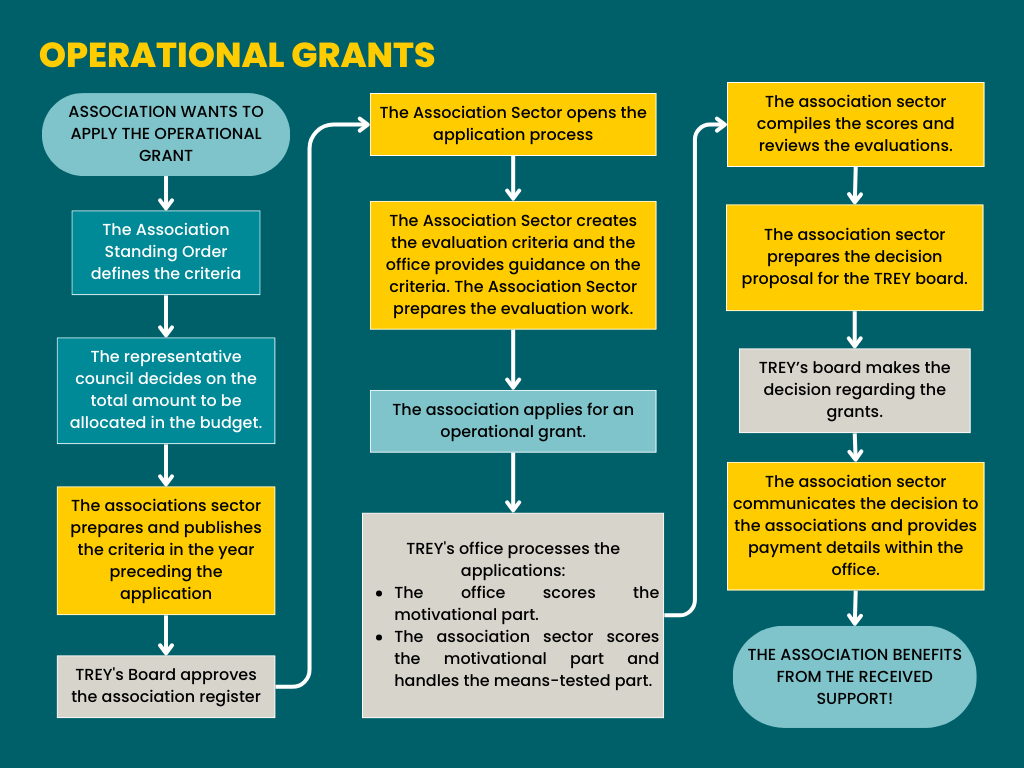It’s that time of year again when TREY’s associations sector has completed one of its biggest annual tasks. That means, once again, associations are receiving funds! In the meeting held on June 13, we distributed €81,000 in operational grants to 136 associations within TREY.
So, what exactly is an operational grant?
Operational grants are TREY’s way of supporting the associations operating within TREY. The support is divided into two parts: a motivational part and a means-tested part. The means-tested part is allocated to associations based on their financial need. Additionally, in distributing the means-tested portion, we consider the application justifications, the financial need assessed based on basic and financial information, and the size of the association. The motivational part is based on the responses given by the associations about their activities. Associations respond according to predefined criteria that cover, among other things, event organization, equality, advocacy, sustainable development, and good governance. The responses are scored by TREY’s office, and funds are distributed to the associations based on the points they receive. Through the motivational part, we also encourage associations to conduct high-quality activities and develop their operations.
Why does TREY give such funds to associations? Do other student unions do this?
It is important to support the associations operating within TREY. Through this support, we can also help the smaller associations that may organize cultural or sports activities for our students. For many associations, the operational grant is one of the biggest sources of funding for the year.
Other student unions also provide similar support to associations. For example, the Student Union of the University of Jyväskylä (JYY) grants support to associations twice a year: a basic part in the spring and an activity-based part in the fall, where associations answer questions about their activities, just like in Tampere. In JYY, the amount of the basic part paid in the spring is based on whether the association is a subject association, a hobby association, or a representative council group.
The Student Union of the University of Turku (TYY), on the other hand, provides funds once a year, similar to TREY. At TYY, the operational grant consists of a scored section related to the associations’ activities and a basic part granted to subject and faculty associations. The Aalto University Student Union (AYY) also supports their associations with operational grants. Their operational grant consists of a financial needs-based part and a scored part where the quality of the associations’ activities is assessed. Our friends in Eastern Finland also grant operational support once a year to associations, such as the Student Union of LUT University (LTKY).
In summary, based on a small but comprehensive sample, it can be said that other student unions also do this!
How does the grant allocation process work in practice?
The process always begins in the year before the application year with the preparation and finalization of the criteria. Additionally, the representative council determines the final amount that can be allocated to associations during the budgeting process. At the end of the year, the criteria are communicated to the associations, and the project continues with the preparation of the application form, communication, and scoring sheets at TREY’s office. When the application period starts, associations apply according to the specified procedure and answer the questions on the form.
Once the application period ends, the most labor-intensive phase of the process begins: reviewing the applications. The applications are reviewed in such a way that each sector of TREY’s office evaluates the answers corresponding to their respective questions. For instance, the social policy sector participates in evaluating both the sustainable development and social policy questions, while the events sector scores the questions related to events. What does the associations sector do then? In the associations sector, we read through every question so that one person from the sector scores one question. The average of these two scores is the association’s score for one question. If there is a discrepancy of more than 2 points, the scoring is re-evaluated. Alongside the motivational part, the associations sector also reviews the applications for the means-tested parts and examines the submitted attachments, such as financial statements.
Once all the points are gathered and the means-tested part is processed, it’s time to compile a proposal for TREY’s board, which makes the final decision on the amounts to be distributed at its meeting. After this, we communicate the decision and forward the payment information to TREY’s financial sector. After all this, we take a summer break and start the process again from the preparation phase.
TL;DR: The process is long, and here is a summarized visual representation of the entire process!
Facts About the 2024 Operational Grant Application
This year’s application resulted in the following data:
- 136 applications
- 197,598 words in the responses to the incentive-based part (excluding answers sent in attachments)
- which translates to 762 pages in Word, using Calibri font, size 11, and 1.5 line spacing.
- €97,920 requested for the means-tested part
- 3 applications with incorrectly spelled association names
- Many hours spent reading responses by TREY staff and board members
What are our next steps?
Now that the task is behind us and the associations have received their funds, it’s time for us to reflect on the process as a whole and review the responses. Last year, we examined the impact of various factors on the scores received by associations. We looked at, for example, the impact of the size of the association’s premises or the association’s wealth on the scores. We will present similar observations to association members again in the fall.
I, for one, learned a lot about our associations from reading the responses and encourage you to explore the activities of different associations boldly. We have around 180 associations that organize activities ranging from parties to sports and from culture to beer brewing. It’s wonderful that we have such a diverse association field!
– Riikka, Board member in charge of association and volunteer affairs
